News
Place names say who we are: Nallur triumphs Nellore

by S. Ratnajeevan H. Hoole
The Perahera in Kandy was permitted even with artistes catching Covid. The Nallur Thiruvilla was banned. Our terrorizing police had parades at the temple for TV but shut down streets and diverted traffic although no one was worshiping. When robbers came two doors away (21.08.2021) during curfew, the police emergency number did not answer, and the normal number was hung up when I called. The police do not protect us. My Nellore is being robbed of its name and history.
Rick Grannis of UC Irvine found American racial populations being organized according to “who is down the street.” I address here the subtle fight over place names to suggest the dwellers’ caste. Nellore is the name of Nallur in early church records; streets correlate to caste and land price.
We see street segregation in the Tamil Hindu Epic Chilappathikaram Canto 5. Streets are reserved by caste having their “respective localities.” Jewellers, copper/iron mongers, cobblers, grain-sellers, et al., had their reservations – even mutton vendors, fishmongers, and prostitutes. These places in the city went by the name of Maruvurppakkam (the Other Village Side). In Pattinappakkam (Town Side) dwelt highly renowned great men.
Nellore was the seat of the Jaffna Kingdom of the Aryachakaravarthies. Chekarajacekaramalai says their lineage was Brahmin (I doubt it). Our royals naturally upheld agamic Hindu culture; particularly caste.
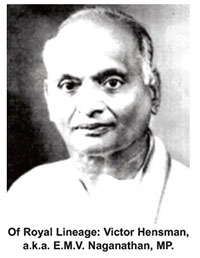 Madurai’s practice was upheld in Nellore – see the street map from the Jaffna Public Library. The CMS St. James’ stands where the principal Hindu Temple stood at Nallur Centre. Guardian-temples stood in agamic fashion, namely Chattanaathar Kovil (North), a destroyed untraceable temple (West), Moothavinayagar Kovil (South) and Veyyilviluntha Pillaiyar Kovil (East). The map says what caste lived where. People who want a high-status buy into Vellala areas.
Madurai’s practice was upheld in Nellore – see the street map from the Jaffna Public Library. The CMS St. James’ stands where the principal Hindu Temple stood at Nallur Centre. Guardian-temples stood in agamic fashion, namely Chattanaathar Kovil (North), a destroyed untraceable temple (West), Moothavinayagar Kovil (South) and Veyyilviluntha Pillaiyar Kovil (East). The map says what caste lived where. People who want a high-status buy into Vellala areas.
There is push back. For example, North of Chattanaathar Kovil is where the Kaikular of middling caste live (palace guards). It was called Kaikulanj Chanthai, now renamed Kalviankadu. This area North of the Palace was occupied by the Portuguese garrison. Many Kaikular show admixture: physical stature (like TELO’s Sri Sabaratnam), pink skin, and grey eyes which are now ascribed to Brahmin admixture and used by Kaikulas to make claims to Brahmin-ritual, like shorter periods of mourning.
The upper castes lived on the main roads within the circle of the guardian temples centred on CMS St. James’, called Changili Thoppu (King Changili’s Garden). People in the by-lanes were of lower castes – typically workers from the trades and musicians, whom the royals needed, and untouchables.
The Rev. John Hensman was the first Anglican priest from Jaffna. It is a shame that Dr. Victor Hensman (later Naganathan) of that family whose life we celebrated only on 15 Aug. 2021 through an international Zoom conference, abandoned that proud heritage and took on the name E.M.V. Naganathan, MP, SJV Chelvanayakam’s righthand.
The high-caste Circle stopped East of Veyyil Viluntha Pilllaiyar Kovil where Chemmany Road (leading to Chemmany) ends on the map. East of that is Nayanmaarkattu where field workers lived. The unnamed road at the top-right of the map was Nayanmaarkattu Veethi (becoming Aadiyapaatham Road) going to Thirunelveli Market. The short stretch of road from Kachcheri-Nallur Road towards the temple as Point Perdro curves toward Muththirai Chanthai was exclusively for Musicians, who could be heard practising their sweet music up to the mid-1960s. They have sold their lands to those seeking caste-upgrade by coming closer to the Nallur Temple.
Many new families have moved in buying land especially as the Christians left Nellore. Changili Thoppu where CMS St. James’ stands and the Palace stood, contains Muthirai Chanthai (Stamp Market, where stood a market to my times, and named so because the King’s tax collectors stamped in indication that taxes had been paid). That market is gone now so new-comers give away their late-coming status by calling it Muththirai Chanthi (Stamp Junction), although Church deeds refer to “Muththirai Chanthai.”
Chemmany Road
Chemmany Road, running by the old palace and central temple with the stretch of Point Pedro Road in front of the Palace entrance, was one of the most important roads. Fr. V. Perniola (The Catholic Church in Sri Lanka) makes occasional reference to the early church in Jaffna in Portuguese times. The early missionaries were Franciscans. King Changili martyred the first Franciscans and many Tamil saints, including his own son. The name Chemmany Road is commonly thought to have its etymology in chem (red) mani (stone, jewel). That, however, is far-fetched because there are no red stones or gems in the area. The likely etymology is chem (holy-red) munn (sand)-ee (the place that has red sand). Chemmany is the place where martyrs’ blood was spilt. As such, the church precincts and the Teachers’ Training College, with its associated Practising School, are hallowed grounds for Christians, RC and non-RC.
The Rev. Elijah Hoole married a girl from Nallur and the Hooles have lived on Chemmany Road for generations. Church deeds testify that our land belonged to my great-great grandmother “Mrs. E. Hoole.”
Nellore Temple History
St. James’s Church is built on the original Central Temple razed to the ground presumably in June 1619 when the Portuguese launched an expedition against Changili II. He took baptism in Goa before his beheading for his crimes, testifying “I would rather die a Christian Coolie than a Heathen King” and “uttering the sweet name of Jesus” (Queyroz, 690-1). His two Queens were preached to by Friar Antonio de Santa Maria (Queyroz 686ff); involving long debates about religious choices with the Queens showing appreciation for Christianity but not enough to convert – until one Queen is moved to ecstatic tears and gets baptised and preaches to the other who too converts. She donated the land where the central temple stood to the Church. On that spot was built a Roman Catholic chapel occupying the St. James’ altar and vestry, and a schoolhouse. Thus St. James’ turned 557 years old in June 2019 when it had Mary as part of its name (citing Roman Catholic historian Rev. Dr. Fr. J. E. Jeyaceelan), although the 200th anniversary recently celebrated was only of the Anglican Church.
Following replacement of the Central Temple by a Roman Chapel, historic documents refer to the Nellore Temple having been built by Chembaha Perumal. There is deliberate spinning between the razed temple and the new. The Wikipedia says, “According to the Yalpana Vaipava Malai, the temple was developed at the site in the 13th century by Buwaneka Bahu, a minister to the King of Kotte. Chembaha Perumal is credited with building the third Nallur Kandaswamy temple”. Where were the first and second? Other so-called encyclopedic sources say, “the Temple’s foundation was laid in 948 AD. … Due to invasion of foreigners, the temple had to be relocated several times in different places within [the] Nallur area.” Nonsense.
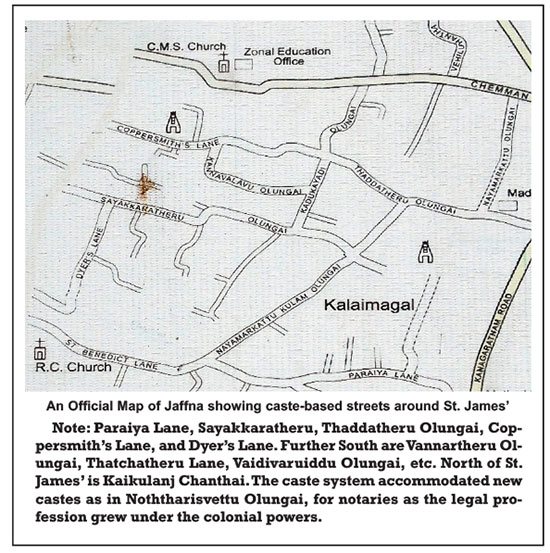
After 948 AD it was the time of the ardently Saivite Cholas, who never would have destroyed a Murugan Temple, and then of the Aryachakaravarthies who too promoted Saivism. So why did the temple have to be relocated several times within Nallur whereas those escaping invaders would have fled Nellore?
However, many writers blame Phillippe de Olivero – a Portuguese army commander – for destroying all Hindu temples in Jaffna in 1620. His expedition against Changili II was in 1618. So where was the Nallur temple he destroyed? Which? When? That account is doubtful. The actual destruction would have been in 1619 under de Olivero by when a Christian Chapel was already standing. That would have been where the original temple was. Stories of its relocation need clear proof of when and to where it was relocated.
The present-day Nellore Temple was really built (as a new temple, not rebuilt) when the Dutch allowed it. According to what I was taught in primary school and to India’s Jaffna Consul General’s web site, “It is believed that there was a shrine dedicated to an Islamic Sufi saint in the temple complex from 1734 to 1749 which was relocated in 1749 when the temple structure was built.”
Clearly the present temple stands on “The Other Village Side” in the Muslim quarter with bad connotations for caste. The original Nellore (Paddy Village, Chemmany to this day having paddy fields cultivated by Palla field workers) had to be rescued and made Nallur, the place of good people. The Muslims were pushed further West into Chonaka Theru.
What was done to the Sufis was exactly what the Portuguese did to the Hindus, and the LTTE did to the Muslims in Oct. 1990.
So the Nallur temple cannot be older than late Dutch rule – late in the Eighteenth Cent. when the Dutch began giving permission to build temples. (They never attacked Mosques because they contained no idols).
We see a lot of self-enhancing expansionist heritage history concerning Nallur. Wikipedia even claims, “Part of the original Shivalingam of the Nallur Kandaswamy Temple was located in the Vicarage [of St. James’] till 1995 when it was destroyed during the recapture of Jaffna by Sri Lanka armed forces. Nonsense. I lived in the vicarage from 1956 to 1967. There was no Sivalingam.
Battle for Nellore
St. James’ is the centre of Nellore made into Nallur to claim high caste status, although according to the map, several lower castes also live in Nellore outside the circle round St. James’.
The new temple stands where Muslims and traders ejected from there lived; technically on low-caste soil. It was Maruvurppakkam rather than central Nallur. Reclaiming Pattinapakkam is a long-term project in progress. For that, the temple area must expand East and Nayanmaarkattu expand West, thereby eliminating the real Nallur.
I have begun receiving letters addressed to Nayanmaarkattu Road rather than Chemmany Road. St. James’ up to 1975 or so was dominated by Vellalas, but now only about 3 families remain. The other castes to the east (Nayanmaarkattu) and south (Ariyalai) outside the circle around St. James’ dominate the church, even though the Hindus among them have stone-throwing and fisticuffs when there is Paraya-Palla love. With all Wardens today non-Vellalas, they have lumped our family with Nayamaarkattu for administrative purposes arguing that Changilithoppu is now part of Nayanmaarkattu. Likewise, Paraya Street now has disappeared into St. Benerdict’s Street. The North-South Nayanmaarkattu Olungai leading to Nayanmaarkattu is removed and now runs East-West to Kanaharatnam Road leading to Ariyalai. However, since the Provincial Department of Education has illegally encroached on the CMS Teachers’ Training College and Vellalas (or aspiring Vellalas) there will not use the Nayanmaarkattu Road as address in preference to Chemmany Road, obliterating that Chemmany Road address is uphill.
The attempt to replace “Chemmany Road” with the name “New Chemmany Road” elsewhere is ongoing. A road by this name is seen as having been started from Kaikulanj Chanthai. It does not even reach Chemmany. The Nallur sub-Post Office was within the circle by Chattanaathar Kovil. That has been moved to Kaikulanj Chanthai diminishing the claims of the original Nallur.
When I returned to Sri Lanka and was looking for land close to St. James’, my Hindu relations told me my Hindu cousin in new Nallur was selling his land. When I inquired, he denied it. My relations said he was untruthful. Three months later he had sold it to a Hindu. There is an ongoing attempt to call the temple area Siva Boomi. So meat-eating Christians are not welcome (although I am vegetarian when most Hindus re not). Even the strict king of Kannaki’s, Pandiyan Nedunj Chelian, permitted mutton-vendors and fishmongers; but not the Velllalas of Nallur Temple. Eating-houses are vegetarian. A meat-eating German Shepherd on Siva Boomi has been switched to vegetarian.
The real Nellore is vanishing. The usurper Nallur stands on sufi soil and is in bad hands.
News
French Ambassador pledges support for relief efforts
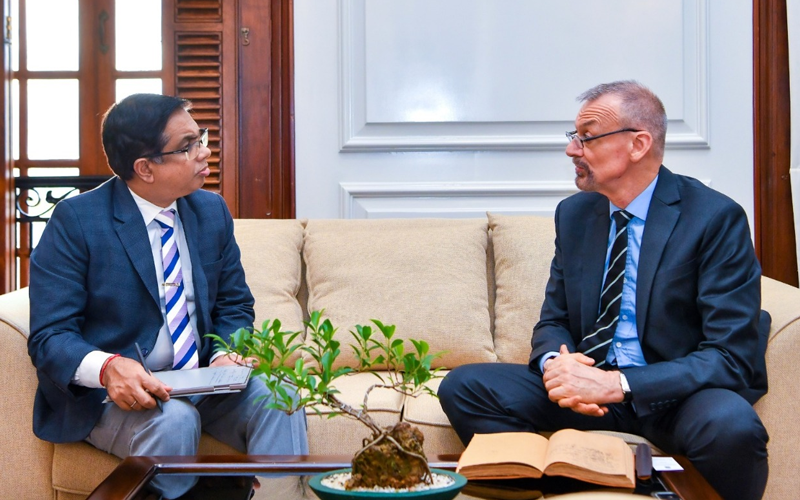
A meeting between the Secretary to the President, Dr. Nandika Sanath Kumanayake and the French Ambassador to Sri Lanka, Rémi Lambert, was held on Tuesday (09) afternoon at the Presidential Secretariat.
During the discussion, the French Ambassador assured the Secretary to the President that the French Development Agency would extend its support to the Government’s programme for providing relief to those affected by Cyclone Ditwah and for rebuilding Sri Lanka. He further stated that steps are being taken to dispatch a team of experts to the country in the near future.
The Deputy Head of Mission at the French Embassy, was also present on this occasion.
Latest News
India extends multi-front support to Sri Lanka’s cyclone relief efforts

India has strengthened its humanitarian support to Sri Lanka in the aftermath of Cyclone Ditwah, providing critical air assets, emergency supplies, engineering equipment and medical aid to bolster national rescue and recovery operations.
India dispatched an additional MI-17 helicopter to assist the Sri Lanka Air Force (SLAF) in ongoing air rescue missions on Tuesday (09). Two MI-17 V5 helicopters of the Indian Air Force had been operating in Sri Lanka from 29 November, conducting around 90 sorties, rescuing approximately 270 survivors, airlifting about 50 tonnes of relief material to inaccessible areas and relief camps and deploying 57 Sri Lankan troops to cut-off locations.
Having completed their flying hours, the two helicopters returned to India on Sunday (08) for mandatory maintenance and a fresh MI-17 aircraft arrived at Katunayake Airport to continue operations alongside the SLAF.
The aviation support comes alongside major maritime assistance. The Indian naval vessel INS Gharial arrived at the Port of Trincomalee on Sunday (08) carrying a 700-tonne humanitarian shipment, marking India’s fifth naval relief consignment to Sri Lanka, apart from 10 aircrafts and 5 helicopters, which have contributed towards rescues and relief operations, since the cyclone.
The shipment included essential food supplies such as pulses, sugar and milk powder, as well as bed sheets, towels, sarees, dhotis and tarpaulins for families displaced by flooding and landslides. The emergency aid is being directed to the hardest-hit districts through local relief agencies.
In a further show of engineering support, India has also handed over a 63-ton Bailey bridge and a consignment of essential medicines to Sri Lankan authorities to restore connectivity and meet urgent medical needs in affected communities.
The cargo was received by General Chaminda Wijerathne of the Sri Lanka Army Headquarters, Sunil Jayaweera, former Director Preparedness of the Disaster Management Centre (DMC), now volunteering in the response and Shan Pathirana, Deputy Director of the DMC Awareness Division.
The handover was facilitated by the Indian High Commission in Colombo.
These coordinated air, sea and engineering initiatives underscore India’s continued commitment to supporting Sri Lanka during its national emergency response and long-term recovery. The assistance forms part of India’s broader partnership to restore essential services, reconnect isolated communities and provide relief to thousands affected by Cyclone Ditwah.
News
Relief Cargo from the UAE arrives in Sri Lanka
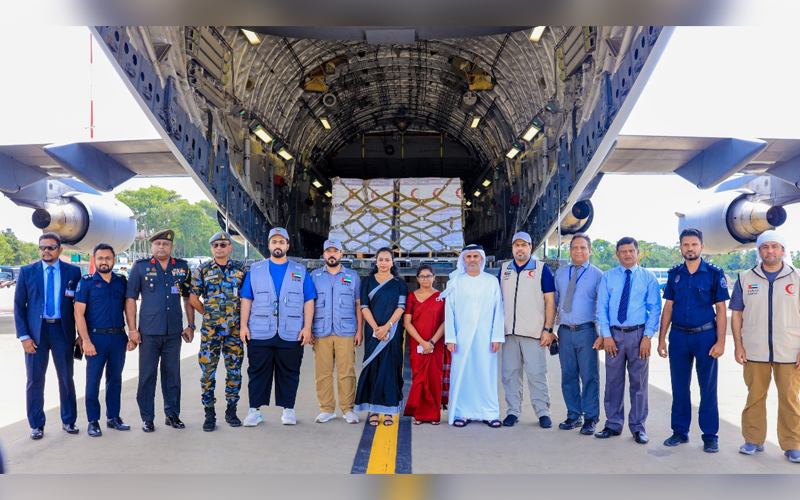
In a significant gesture of solidarity and support, a relief cargo from the United Arab Emirates has been officially received in Sri Lanka.
The cargo was accepted by key representatives from the Middle East Division of the Ministry of Foreign Affairs, including Ms. Ishara De Silva and Ms. Sajeeda Rasheed, both serving as Assistant Directors.
Joining them were Sunil Jayaweera, a former Director of Preparedness at the Disaster Management Center (DMC), who has returned to volunteer after retirement and . Shan Pathirana, Deputy Director of the Awareness Division at DMC.
The cargo was presented by the Deputy Head of Mission, representing the UAE, highlighting the strong ties and commitment to humanitarian aid between the two nations.
-

 News2 days ago
News2 days agoOver 35,000 drug offenders nabbed in 36 days
-

 News6 days ago
News6 days agoLevel III landslide early warning continue to be in force in the districts of Kandy, Kegalle, Kurunegala and Matale
-

 Business4 days ago
Business4 days agoLOLC Finance Factoring powers business growth
-

 News4 days ago
News4 days agoCPC delegation meets JVP for talks on disaster response
-

 News4 days ago
News4 days agoA 6th Year Accolade: The Eternal Opulence of My Fair Lady
-

 News2 days ago
News2 days agoRising water level in Malwathu Oya triggers alert in Thanthirimale
-

 News1 day ago
News1 day agoCyclone Ditwah leaves Sri Lanka’s biodiversity in ruins: Top scientist warns of unseen ecological disaster
-
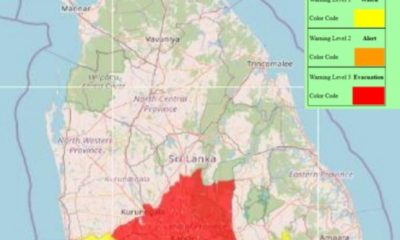
 Latest News4 days ago
Latest News4 days agoLandslide RED warnings continue to be in force for the Districts of Kandy, Kegalle, Kurunegala, Matale and Nuwara Eliya













